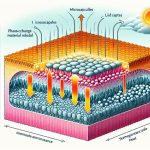Imagine wearing a fabric that adjusts to your body temperature, keeping you perfectly comfortable no matter the weather. That's the potential of Phase-Change Materials (PCMs) in smart fabrics. By absorbing and releasing thermal energy, PCMs can provide personalized climate control, enhancing comfort and performance. This innovation promises not only improved wearability but also energy efficiency and sustainability. With advancements in encapsulation techniques, PCM-infused textiles could revolutionize the way we think about clothing. But how exactly do these materials work, and what challenges lie ahead for their widespread adoption?
Table of Contents
Key Takeaways
- Phase-change materials in smart fabrics ensure consistent temperature regulation, enhancing comfort and performance in diverse conditions.
- PCM-infused textiles store and release thermal energy, providing dynamic climate control for personalized comfort.
- Advanced encapsulation techniques improve the durability and efficacy of PCMs in smart fabrics.
- Smart fabrics with PCMs enhance energy efficiency by reducing the need for external heating and cooling.
- PCM-infused garments extend the lifespan of clothing and support sustainability through reduced washing frequency and water conservation.
Understanding Phase-Change Materials
Phase-shift materials (PSMs) are substances that absorb and release thermal energy during the process of melting and solidifying. To truly understand PSMs, you need to grasp their material properties and how they influence PSM performance. PSMs exploit the latent heat absorbed or released during pivotal heat exchanges, making them ideal for thermal regulation in smart fabrics.
You'll want to focus on key material properties like melting point, thermal conductivity, and specific heat capacity. These properties determine how effectively PSMs can manage thermal energy. For instance, a PSM with a melting point that aligns with the human body's comfort temperature range can maintain a stable temperature when integrated into fabrics.
PSM performance is also influenced by the material's ability to undergo numerous phase alterations without degradation. Durability and reliability are essential, especially in smart fabrics that demand consistent performance over time. You should also consider the encapsulation techniques used to integrate PSMs into fabrics, which affect their overall efficacy.
Mechanisms of Heat Regulation
You'll find that smart fabrics use phase-change materials to manage heat through several key mechanisms.
They store thermal energy, adapt to temperature changes, and employ microencapsulation technology to enhance performance.
These features guarantee you stay comfortable in varying conditions.
Thermal Energy Storage
Thermal energy storage in smart fabrics hinges on their ability to absorb, store, and release heat, guaranteeing consistent temperature regulation. These fabrics utilize phase-change materials (PCMs) that undergo a transformation between solid and liquid states. When the temperature rises, PCMs absorb latent heat and melt, storing thermal energy. Conversely, as the temperature drops, they solidify, releasing stored heat. This cycle of absorption and release enables smart fabrics to maintain a stable temperature, promoting energy efficiency.
You'll appreciate how smart fabrics can enhance thermal comfort. By efficiently managing heat exchange, these materials reduce reliance on external heating or cooling systems. Imagine wearing a jacket that keeps you cool on a sunny afternoon and warm as the evening chill sets in. The latent heat absorbed during the day is released gradually, providing you with a consistent comfort level. This not only improves your personal comfort but also contributes to overall energy conservation.
To harness these benefits, it's essential to integrate high-quality PCMs into the fabric's structure. Properly engineered, these materials guarantee that your smart fabrics perform optimally, adapting seamlessly to your body's thermal needs. Mastering this technology empowers you to experience unparalleled comfort and efficiency.
Temperature-Adaptive Properties
Smart fabrics excel in temperature-adaptive properties by leveraging the unique mechanisms of heat regulation provided by phase-change materials. These materials operate by absorbing, storing, and releasing thermal energy during phase alterations, such as melting and solidifying.
When you wear climate responsive clothing embedded with phase-change materials, the fabric actively manages your body temperature. As you heat up, the material absorbs excess thermal energy, keeping you cool. Conversely, when you cool down, it releases stored heat to warm you up, ensuring continuous thermal comfort.
This fabric innovation redefines comfort technology by making your clothing responsive to varying temperatures. No more layering up or down throughout the day. Smart textiles equipped with phase-change materials adapt to your needs, providing personalized climate control.
By maintaining an ideal temperature, these smart fabrics enhance your comfort and performance, whether you're in extreme outdoor conditions or fluctuating indoor environments.
With advancements in smart textiles, you're not just wearing clothes; you're experiencing a sophisticated interaction between fabric and environment. This seamless integration of comfort technology into everyday wear marks a significant leap in fabric innovation.
Embrace the future of climate responsive clothing and enjoy unparalleled comfort and adaptability.
Microencapsulation Technology
Incorporating microencapsulation technology, smart fabrics trap phase-change materials within tiny capsules, enhancing their ability to regulate heat efficiently. When the temperature rises, these capsules absorb excess heat, changing from solid to liquid. As the temperature drops, they release stored heat, reverting to a solid state. This dynamic process guarantees ideal thermal comfort.
You'll find that the material composition of these encapsulated fabrics greatly boosts their performance. By maintaining a stable internal temperature, these fabrics improve user comfort regardless of external conditions.
Here's how microencapsulation elevates smart fabrics:
- Enhanced Durability: Encapsulated materials are shielded from wear and tear, extending the fabric's lifespan.
- Consistent Performance: The controlled release and absorption of heat ensure reliable thermal regulation over time.
- Versatility: Suitable for a range of industrial applications, from athletic wear to aerospace, due to their adaptive properties.
- Energy Efficiency: Reduces the need for external heating or cooling, providing environmental benefits and cost savings.
Applications in Smart Fabrics
You can find phase-shift materials in a variety of smart fabric applications, from athletic wear to medical textiles. In athletic wear, PCM-infused fabrics provide superior wearable comfort by regulating body temperature. When you're active, the material absorbs excess heat, preventing overheating. As you cool down, it releases the stored heat to maintain a comfortable body temperature. This climate control feature helps athletes optimize their performance and endurance, making PCM-infused fabrics a game-changer.
In medical textiles, phase-shift materials offer precise temperature management essential for patient care. For example, bedding and garments designed for patients with temperature regulation issues use PCMs to ensure they remain at an ideal temperature. This is particularly beneficial for those with conditions like hyperthermia or hypothermia. By maintaining a stable temperature, these smart fabrics can enhance patient comfort and potentially improve recovery outcomes.
Beyond these, phase-shift materials are also used in outdoor gear and military uniforms, where climate control is vital. Whether you're hiking in unpredictable weather or serving in extreme conditions, PCM-infused fabrics provide the necessary thermal balance, ensuring you remain comfortable and focused on your activities.
Benefits of PCM-Infused Textiles
PCM-infused textiles offer enhanced thermal regulation, optimizing your comfort in varying temperatures. These materials absorb, store, and release heat as needed, providing you with a stable microclimate. This translates to several key benefits that can improve your experience with fabrics.
- Comfort improvement: PCM-infused textiles adapt to your body's needs, keeping you cool when it's hot and warm when it's cold. This dynamic adjustment optimizes you're always at your ideal temperature, reducing discomfort and increasing overall satisfaction.
- Energy savings: By reducing the need for external heating or cooling, PCM textiles can lead to significant energy savings. This isn't only beneficial for your wallet but also helps in reducing energy consumption, aligning with sustainable living practices.
- Performance enhancement: For athletes and outdoor enthusiasts, maintaining an optimal body temperature is essential for peak performance. These textiles ensure that you stay focused and effective, avoiding the distractions caused by temperature fluctuations.
- Sustainability advantages: PCM-infused textiles contribute to sustainability by extending the life of garments and reducing the frequency of washing and drying. This not only conserves water and energy but also minimizes your environmental footprint.
Challenges and Solutions
Despite their many advantages, smart fabrics with phase-change materials face several obstacles that require addressing. One significant issue is the durability of these materials. When integrated into textiles, phase-change materials (PCMs) can deteriorate over time, diminishing their effectiveness. You'll also encounter challenges in the manufacturing processes. Integrating PCMs into fabrics demands precise control and innovative designs, which can complicate scaling production.
Another challenge is maintaining the comfort and breathability of the fabric. PCMs can sometimes introduce bulk or rigidity, making the fabric less pleasant to wear. Additionally, the cost of producing PCM-infused textiles remains high, limiting their accessibility to broader markets.
To address these obstacles, you can explore advanced encapsulation techniques that shield PCMs from deterioration. Improving manufacturing processes through automation and precision engineering can also help. Furthermore, developing more flexible and lightweight PCM composites will enhance comfort without compromising functionality. Cost reduction is another vital area; investment in research and development can yield more affordable materials and production methods.
Here's a quick overview of the challenges and potential solutions:
| Challenge | Solution |
|---|---|
| Durability | Advanced encapsulation techniques |
| Manufacturing complexity | Automation and precision engineering |
| Comfort and breathability | Flexible and lightweight PCM composites |
| High production cost | Investment in R&D for affordability |
Future Trends and Innovations
You'll soon see advanced thermal regulation and energy-efficient textiles becoming the norm in smart fabrics.
Innovations will make it easier to integrate these materials into wearable tech, enhancing comfort and functionality.
Stay tuned for breakthroughs that could redefine how you experience clothing and technology.
Advanced Thermal Regulation
Innovations in smart textiles are set to revolutionize thermal regulation by integrating advanced phase-change materials that react dynamically to temperature changes. These new materials are designed to enhance both heat retention and moisture management.
Imagine a fabric that keeps you warm when it's cold and cool when it's hot, all while maintaining peak moisture levels. This dynamic response guarantees fabric breathability and precise temperature control, making your clothing more comfortable and efficient.
Here's how these innovations will transform your wardrobe:
- Dynamic Heat Retention: Textiles can store and release heat as needed, keeping you at the ideal temperature.
- Advanced Moisture Management: Integrated phase-change materials help regulate sweat, keeping you dry and comfortable.
- Enhanced Fabric Breathability: The materials allow air to flow, preventing overheating and ensuring a fresh sensation.
- Peak Temperature Control: These textiles adjust to external conditions, providing consistent comfort in varying environments.
Energy-Efficient Textiles
Imagine textiles that don't just look good but also minimize energy consumption by intelligently adapting to your body's needs. That's the promise of energy-saving fabrics, where sustainable innovation meets smart design. These fabrics leverage phase-change materials (PCMs) to regulate temperature dynamically, reducing the need for external heating or cooling devices. By absorbing, storing, and releasing heat as needed, they ensure maximum comfort while reducing energy use significantly.
You'll find that these textiles are more than just eco-friendly solutions; they're a leap towards smarter living. The functional performance of these materials means you stay warm when it's cold and cool when it's hot, all without additional layers or gadgets. This adaptability not only enhances your comfort but also reduces the environmental impact, making it a win-win for both you and the planet.
As the industry moves towards integrating these advanced materials, expect a surge in innovations that prioritize both sustainability and efficiency. From daily wear to specialized gear, energy-saving textiles promise a future where fashion and functionality go hand in hand, setting new standards in smart design and eco-conscious living.
Wearable Tech Integration
Building on the promise of energy-saving fabrics, the next frontier in smart textiles involves integrating wearable tech that enhances functionality and user experience. Imagine wearing performance wear that not only regulates your body temperature but also tracks your health metrics, or donning a jacket that charges your devices on the go.
The synergy between fashion tech and advanced materials is paving the way for garments that aren't just stylish but also highly functional.
To master the future trends in wearable tech integration, consider these key innovations:
- Embedded Sensors: These can monitor essential signs like heart rate and body temperature, providing real-time health data.
- Energy Harvesting: Fabrics that capture solar or kinetic energy to power small devices, reducing the need for external chargers.
- Interactive Textiles: Touch-sensitive materials that can control your smartphone or other devices directly from your clothing.
- Adaptive Materials: Textiles that change their properties (e.g., color, texture) in response to environmental conditions or user commands.
Balancing design aesthetics with functionality is crucial. As you explore the evolving landscape of smart fabrics, keep an eye on how these innovations transform everyday wear into intelligent, responsive garments.
Frequently Asked Questions
How Do Phase-Change Materials Differ From Traditional Thermal Insulation?
You'll find phase-change materials excel in heat regulation and performance. Unlike traditional insulation, they store and release heat, boosting energy efficiency and comfort. This dynamic response enhances your overall experience, especially in varying temperatures.
Are Phase-Change Materials Safe for Prolonged Skin Contact?
You won't believe how safe phase-change materials are for your skin! They're rigorously tested and designed for long-term wear, ensuring skin safety even with prolonged contact. Rest assured, you're in expert hands with these innovative materials.
What Is the Environmental Impact of Producing Phase-Change Materials?
When considering the environmental impact of producing phase-change materials, you should evaluate resource consumption and waste management practices. Efficient resource use and innovative recycling methods can mitigate negative effects, ensuring sustainable production practices.
How Durable Are Phase-Change Materials in Fabrics After Multiple Washes?
You're wondering about fabric lifespan and washing effects. Phase-change materials can maintain their properties for many washes, but durability varies. High-quality treatments guarantee better durability, so focus on reputable brands for best performance.
Can Phase-Change Materials Be Recycled or Reused?
Did you know 85% of textiles go to landfills annually? Recycling methods for phase-change materials are evolving, offering promising reusability options. You can help reduce waste by supporting these advancements and making sustainable choices.







